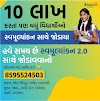- Home-icon
- શૈક્ષણિક સમાચાર (Educational News)
- _ઓનલાઈન શિક્ષણના વિડીયો (ONLINE EDUCATION VIDEOS)
- __ધોરણ 1 (ધોરણ ૧)
- __ધોરણ 2 (ધોરણ ૨)
- __ધોરણ 3 (ધોરણ ૩)
- __ધોરણ 4 (ધોરણ ૪)
- __ધોરણ 5 (ધોરણ ૫)
- __ધોરણ 6 (ધોરણ ૬)
- __ધોરણ 7 (ધોરણ ૭)
- __ધોરણ 8 (ધોરણ ૮)
- __ધોરણ 9 (ધોરણ ૯)
- __ધોરણ 10 (ધોરણ ૧૦)
- __ધોરણ 11 (ધોરણ ૧૧)
- __ધોરણ 12 (ધોરણ ૧૨)
- _Primary School (પ્રાથમિક શાળા સમાચાર)
- _Paripatra (ઉપયોગી પરીપત્રો)
- _Std 1 to 12 Text Books (ધોરણ ૧ થી ૧૨ના પાઠયપુસ્તકો)
- _LEARNING OUTCOMES (અધ્યયન નિષ્પતિઓ)
- _CCC EXAM MATERIALS (સીસીસી પરીક્ષા મટેરિયલ)
- નોકરી સમાચાર (JOBS NEWS)
- _Latest Jobs (નોકરીની હાલની જાહેરાતો)
- _MATERIALS (મટેરિયલ)
- _Call Letters/ Hall Tickets (કોલ લેટર /હોલ ટીકીટ)
- _ANSWER KEY (આન્સર કી)
- _Results (રીઝલ્ટ)
- HEALTH TIPS (આરોગ્ય હેલ્થ ટિપ્સ)
- LATEST ANDROID APPS (એન્ડ્રોઇડ એપ્લિકેશનનો ખજાનો)
- GOVERNMENT SCHEMES (સરકારી યોજનાઓ)
- ગુજરાતી વેબસાઈટ
Ticker
6/recent/ticker-posts
STD-12 Commerce | VIRTUAL CLASS | Home Learning Virtual Class Daily Video STANDARD- 12 Commerce:
STD-12 Commerce | VIRTUAL CLASS | Home Learning Virtual Class Daily Video STANDARD- 12 Commerce:
What is a virtual Classroom
When you do a search of what a virtual classroom is exactly, you come across a wide variety of definitions.
Some of them relate the virtual classroom to course materials, homework, tests, and assignments that are typically used in self-paced (asynchronous) learning. However, all of these activities are external to the classroom experience.
That is why the definition of a virtual classroom should be related to synchronous online learning, which happens in real time and provides the participants with an experience very close to traditional face-to-face teaching. Here is our understanding of what a virtual classroom is:
What is Virtual Classroom
A virtual classroom is an online learning environment that allows for live interaction between the tutor and the learners as they are participating in learning activities.
In other words, the virtual classroom is a shared online space where the learners and the tutor work together simultaneously. Usually, these interactions take place through videoconferencing.
The participants have tools to present learning content in different formats, as well as to implement collaborative and individual activities.
In this type of interaction, the teacher has the particularly important role of the moderator who guides the learning process and supports group activities and discussions.
The most common tools you can find in a virtual classroom are:
Videoconferencing
Online whiteboard for real-time collaboration
Instant messaging tool
Participation controls
Breakout rooms
Image of Virtual Classroom with teacher and students
Virtual Classroom with teacher and students
Synchronous virtual classrooms have the potential to provide significant added value to online learning by addressing the needs of the learners as they relate to social interaction and psychological safety.
They can also create a new standard in the learning experience that goes above and beyond the physical space of the classroom and traditional teaching methods.
The virtual classroom provides an abundance of opportunities, especially when combined with self-study platforms (learning management systems) or when used in addition to traditional classroom learning activities.
Unlike asynchronous learning environments, the synchronous virtual classroom allows for instant feedback, direct teacher-student interaction, and engaging activities to increase motivation and active participation.
Immediate communication favors relationship building within the group, as well as a sense of community.
Although teaching and learning in a virtual classroom provide an experience similar to the physical one, it requires new pedagogical approaches and a redesign of the instructional model that includes the following characteristics:
Virtual Classroom’s high Interactivity
Collaborative Learning
Student-Centered Instruction
Variety of Content Presentation and Learning Activities
Psychologically Safe Environment
Positive and Constructive Feedback
1. Virtual Classroom’s high Interactivity
Training in a synchronous virtual classroom can only be successful with the active participation and engagement of the learners.
This creates a positive learning environment and helps the participants achieve the expected outcomes. During the virtual session there should be opportunities for frequent interaction between learner and tutor, learner and other learners, and learner and content.
Over the course of the virtual session, the tutor should encourage the students to participate every 3-5 minutes. This can be achieved by a variety of activities such as brainstorming, small group discussion, collaborative and individual tasks, Q&A sessions, hands-on experience, etc.
what is a virtual classroom: Collaborative Learning
2. Collaborative Learning
Collaborative learning means that the learners work together to achieve a common goal, exchange views, clarify the meaning of concepts, or solve problems together. It creates opportunities for cooperation in skills development.
The emphasis is placed on interaction in which common understandings are subject to discussion and are developed precisely through exploring the differences in the participants’ level of knowledge, skills, and positions. Applied in the virtual classroom, this approach is associated with an active process of the collective construction of knowledge using the group as a source of information, a motivational agent, and a means of mutual support.
3. Student-Centered Instruction
The lecture, which is a classic teaching format, often makes students more passive as the focus is on the content and the students must work independently with little opportunity for collaboration.
This approach is more applicable to asynchronous virtual teaching – the tutor creates video lectures and self-directed activities, which the learners cover at their own pace.
Synchronous virtual classes require student-centered instruction in which the learners and the tutor interact equally – active participation, collaborative work, and communication are encouraged in this type of classroom.
The tutor creates opportunities for both independent learning and learning from one another, and guides the learners in developing and practicing the skills they need. This increases the motivation level of the learners, as well as their interest in the learning activities.
What is a virtual classroom: Student-Centered Instruction
4. Variety of Content Presentation and Learning Activities
This approach is related to differentiated instruction, which takes into consideration the differences in the needs, levels, and learning styles of the learners. It favors the creation of a more personalized learning experience and individual success.
When a teacher uses various sources to present the content – text, images, diagrams, audio, video, etc. – this can greatly improve the learning process by providing a flexible learning experience that is tailored to the various needs and preferences of the students. Presenting the content through various types of media retains the attention and interest of the learners.
Blending different types of learning activities within one virtual session also creates opportunities to meet a wider range of the needs of the students.
ALSO READ: UNIT TEST PAPERS (EKAM KASOTI) PAT 2020
Switching between individual work, small group collaboration, and class discussions address the specific learning preferences of all of the students – either to work alone, to interact with the others, or to express themselves in front of a larger group.
5. Psychologically Safe Environment
Interactions in a virtual classroom create the sense of a more informal and safer emotional environment as the learners usually participate from the comfort of their homes..
ધોરણ 11 વર્ચ્યુઅલ કલાસરૂમ તમામ વિડિયો જોવા અહીં ક્લિક કરો
The learning process is much more focused because of the absence of the usual physical distractions that are found in the conventional classroom.
Psychological safety leads to better learning outcomes. It also fosters creativity, confidence, and a willingness to experiment on the part of the learners.
ALSO READ: HOME LEARNING VIDEO MATERIALS
The virtual teacher also has a crucial role here – they need to encourage safe discussions, mutual respect, equal opportunities to participate, and the free sharing of different viewpoints.
The teacher can enhance the psychological safety of the learners and make things more personalized by adding options for self-directed learning, as well as by communicating more frequently with every student through a Learning Management System.
What is a Virtual Classroom
What is a virtual classroom: Safe Environment
6. Positive and Constructive Feedback
Unlike asynchronous virtual platforms, the synchronous virtual classroom allows for immediate feedback from both the tutor and the other participants in both an individual and a general way.
ALSO READ: IMPORTANT UPDATES OF GOVERNMENT PRIMARY SCHOOLS
The key role of the tutor here is to create an atmosphere of positive feedback by guiding the group’s interaction. The need for feedback, which acknowledges the positive aspects of the learners’ performance and gives valuable comments and recommendations for improvement, benefits the education and progress of the students.
It also builds the habit in the group of trying to maintain a positive and constructive tone. All of these factors are vital in assisting the learners to overcome their mistakes without feelings of negativity, as well as by fostering confidence and inspiring them to achieve their full potential.
◾STD- 12 Commerce | VIRTUAL CLASS | Home Learning Virtual Class Daily Video STANDARD- 12 Commerce:
◾IMPORTANT LINKS::
ધોરણ 12 વર્ચ્યુઅલ કલાસરૂમ તમામ વિડિયો જોવા અહીં ક્લિક કરો
ધોરણ 11 વર્ચ્યુઅલ કલાસરૂમ તમામ વિડિયો જોવા અહીં ક્લિક કરો
DATE 4-8-2020 ACCOUNTS VIDEO
DATE 4-8-2020 STATISTICS VIDEO
DATE 5-8-2020 ACCOUNTS VIDEO
DATE 6-8-2020 ACCOUNTS VIDEO
DATE 7-8-2020 ACCOUNTS VIDEO
DATE 7-8-2020 STATISTICS VIDEO
DATE 8-8-2020 ACCOUNTS VIDEO
DATE 8-8-2020 STATISTICS VIDEO
DATE 11-8-2020 ACCOUNTS VIDEO
DATE 11-8-2020 STATISTICS VIDEO
DATE 13-8-2020 ACCOUNTS VIDEO
DATE 13-8-2020 STATISTICS VIDEO
DATE 14-8-2020 ACCOUNTS VIDEO
DATE 14-8-2020 STATISTICS VIDEO
◾ALSO READ:
VIRTUAL CLASSROOM IMPORTANT STUDY VIDEOS:
▪️WATCH STANDARD-9 VIDEOS:
CLICK HERE
▪️WATCH STANDARD-10 VIDEOS:
CLICK HERE
▪️WATCH STANDARD-12 SCIENCE VIDEOS:
CLICK HERE
WE HOPE YOU ARE LEARNING WITH ENJOY AND ALL VIRTUAL CLASSROOM VIDEOS ARE ONE TYPE OF VERY IMPORTANT MATERIAL FOR ALL STUDENTS, SO ITS VERY USEFUL TO ALL..
ALWAYS VISIT WWW.KAMALKING.IN FOR LATEST UPDATES OF NEW GOVERNMENT JOBS AND EDUCATIONAL NEWS...
HERE WE ALSO PUT EXAM IMPORTANT STUDY MATERIALS, CALL LETTER, ANSWER KEYS, QUESTION PAPERS, RESULTS ETC.
We Also Upload To www.kamalking.in, Important Study Materials And Its Very Useful For Government Jobs Preparation.
GOOGLE AD
Contact form
Labels
- 11-12 science
- 1BHK HOME PLAN
- 2BHK HOME PLAN
- 360 VIEW
- 3BHK HOME PLAN
- 4BHK HOME PLAN
- 5G NETWORK
- 7th Pay Committee
- 8th CENTRAL PAY COMMITTEE
- 8th CPC
- AADHAR CARD
- adharcard
- ADHARDISE
- ADHYAYAN NISHPATIO
- ADMISSION
- ADSENSE
- AEI
- AFFILIATE MARKETING
- After Std 12th???
- age limit
- AGRICULTURE
- AI
- AIRTEL SCHEME
- ALL NEWS PAPERS
- AMAZON
- AMUL
- Android App
- Answer Key
- ANTI VIRUS APP
- APAAR CARD
- APAARCARD
- APL LIST
- APMC
- Application to Gov
- APPRENTICESHIP
- ARTICLE 35A
- ARTICLE 370
- ARTIFICIAL INTELLIGENCE
- ASTROLOGY
- ATM
- AUDIO
- AVAILABLE SEATS
- AYODHYA CASE
- AYURVEDIC
- Baby Names
- bad
- BAL SHRUSHTI MAGAZINE
- BALVATIKA
- BANK
- BAOU
- BIRDS VOICE
- bisag
- BLO
- Blue Print
- BOOK
- BPL LIST
- BSF
- BSNL
- BUDGET
- BUSINESS NEWS
- Calculators
- CALENDAR
- call letter
- Call Letters
- CAMPAIGN
- CAR ON RENT IN INDIA
- CASH BACK
- cbse
- CBT
- ccc
- CCC EXAM MATERIAL
- CCC+
- CCE
- Central Government
- CET
- CGL
- CGPA
- CHARGER
- CHAT GPT
- CIRCULAR
- CISF
- CLAT
- Clerk
- CMAT
- CNG
- COAST GUARD
- Computer
- CONSTITUTION
- CORONAVIRUS
- COURT
- CPF
- CRC-BRC
- CREDIT
- CRICKET
- CRPF
- CRYPTO CURRENCY
- CTET
- CURRENCY
- current
- CYCLONE
- D.EL.ED.
- DA
- DAILY CURRENT AFFAIRS
- DAYARO
- DEBIT CARD
- DEFENCE
- DEPARTMENTAL EXAM
- DEVOTIONAL
- DGVCL
- Dictionary
- DIGITAL GUJARAT
- Digital India
- Digital Locker Service
- DIKSHA APP
- DIPLOMA
- Disaster Management
- DISE CODE
- DISTANCE LEARNING
- DIVYANG
- DOCUMENT VERIFICATION
- DONATE CAR TO CHARITY CALIFORNIA
- DRAWING
- Driving licence
- E-MAGAZINE
- EARN MONEY ONLINE
- EBC
- Eclipse
- ECONOMICS
- Education Department
- education of Out States
- EDUCATIONAL NEWS
- EDUSAFAR
- ele
- ELECTION
- ELECTRIC EQUIPMENT
- ELECTRIC VEHICLES
- english
- EPF
- ESSAY
- EXAM DATE
- excel
- EXTERNAL EDUCATION
- FEE PAYMENT
- FEE REFUND
- Festival
- fic
- FILE
- FINAL ANSWER KEY
- Finance Dept
- FIT INDIA
- fix pay
- FIXED DEPOSIT
- FLIPKART
- FLN
- FLOOD
- font
- FOREST
- form
- G-SHALA APP
- GAD
- GADGET
- game
- GAS
- GATE
- GCERT
- GEOGRAPHY
- GEOMETRY
- geovernment scheme
- GET DAILY MESSAGE
- GETCO
- GHARE SHIKHIYE
- GHIBLI IMAGE
- Gift City
- GIRNAR PARIKRAMA
- Gk
- GMAIL
- Gold-Silver Price
- government Employees
- government scheme
- GPAT
- GPF
- GPS
- GPSC
- GPSC DAILY UPDATES
- GPSSB
- GR
- GRADE PAY
- GRADUITY
- GRAMMAR
- GRANT
- GRAPH
- GREENHOUSE
- GSEB
- GSEBESERVICE
- GSET
- GSRTC
- gssb
- GSSSB
- GST
- GUEEDC
- GUJARAT PAKSHIK
- GUJARAT TOURISM
- GUJARAT UNIVERSITY
- gujarati
- gujcet
- gunotsav
- GYAN KUNJ
- GYAN SADHANA
- GYAN SAHAYAK
- GyanParab
- GYANSETU
- GYANSETU SCHOOL
- GYANSHAKTI SCHOOL
- HACKING
- Hair Problem
- hall ticket
- HANTAVIRUS
- HEALTH DEPARTMENT
- HEALTH TIPS
- Help Line
- HERITAGE
- HETUO
- HIGH COURT
- HIGHER PAY SCALE
- Hindi
- HISTORY
- HITESHPATELMODASA
- HMAT
- HNGU
- HOLIDAYS
- HOME LEARNING
- HOME LOAN
- HOROSCOPE
- HOSPITAL JOBS
- HOSTEL
- HOW TO
- HRA
- HSC
- HTAT
- I KHEDUT YOJANA
- IBPS
- ICDS
- ICE RAJKOT
- IELTS
- IIM
- IIT
- IJAFO
- income tax
- INCREMENT
- INDIAN AIR FORCE
- Indian Army
- INDIAN COAST GUARD
- Indian Navy
- Inspire Award
- insurance
- Internet
- interview
- INVESTMENT
- IPHONE
- IPL
- IPO
- ISRO
- ITI
- JAM
- Javahar Navodaya
- JEE
- Jilla Fer Badali
- JIO
- JIOGIGAFIBER
- job
- JRF
- JYOTISH
- KENDRIYA VIDYALAYA
- KGBV
- KHADI
- KHEDUT
- KHEL SAHAYAK
- KHELMAHAKUMBH
- KIDS
- Language
- LATEST MOBILE
- LC
- LEARNING OUTCOMES
- LIC
- LIVE DARSHAN
- LIVE TELECAST
- LOANS
- LOCKDOWN
- LOGBOOK
- LOGO
- LOKSABHA
- LPG
- LTC
- MAHABHARAT
- MAHEKAM
- MAPS
- MARI YOJANA WEBSITE
- MARUGUJARAT
- MASIK PATRAK
- MASVAR AAYOJAN
- MATDAR YADI
- MATERIAL
- Mathematics
- MATHS-SCIENCE KIT
- MATRUTVA RAJAO
- MDM
- MDRA BILL MERA ADHIKAR
- MEDIA
- medicine
- MEDITATION
- MEENA RADIO
- MERIT
- Mesothelioma
- META
- MGVCL
- MICROSOFT
- MINA NI DUNIYA
- MISSION VIDHYA
- Mob Restrict
- MOBILE
- MODEL PAPERS
- model school
- MODULE
- MONGHVARI
- MORTGAGE
- MOVIE
- MP3
- MRP
- MS UNIVERSITY
- MUSIC
- MUTUAL FUND
- My Article
- MYSY
- Nagarpalika Jobs
- NAMO LAKSHMI YOJANA
- NARENDRA MODI
- NAS
- NATAK
- National Highways
- NCERT
- NDA
- NEET
- NEP 2020
- NET
- NEW EDUCATION POLICY
- New Jobs
- NEWS
- NFSA
- NIBANDH
- NMMS
- NOKIA
- notification
- NPS
- NREGA
- NTSE
- NURSING
- OBC
- OJAS JOBS
- old papers
- OMRSHEER
- ONGC
- ONLINE ATTENDANCE
- ONLINE BILL PAYMENT
- ONLINE BOOKING
- Online Material
- ONLINE SHOPPING
- ONLINE TEACHER TRANSFER
- OROP
- PAGAR BILL
- PAN
- panchayat
- paper solution
- Pari
- PARIKSHA AAYOJAN
- PARIKSHA PE CHARCHA
- Paripatra
- Pass
- PASSPORT
- PAT
- patrako
- PAY SCALE
- PAYTM
- PEDAGOGY
- Penshan
- PERCENTILE RANK
- PET
- PETROL-DIESEL-LPG PRICE
- PFMS
- PGVCL
- PH
- PhD
- PITRUTVA RAJAO
- PM AWAS YOJANA
- PM CARES FUND
- PM Kisan Samman Nidhi
- PM WANI SCHEME
- PM YASHASVI Scolarship Scheme
- PM-JAY
- PMMVY
- PMSYM
- POEMS
- police
- POLITICAL NEWS
- Post Office
- PRADHAN MANTRI SHRAM YOGI MAN DHAN YOJANA
- pragya
- PRAPTA RAJA
- PRATIBHASHALI VIDHYARTHI
- Pravasi Shixak
- Praveshotsav
- PRAYER
- PRESS NOTE
- PRET
- PRIMARY SCHOOL
- PROVISIONAL ANSWER KEY
- PSE-SSE
- PSYCHOLOGY
- PTC
- PUC CERTIFICATE
- PUZZLES
- QR CODE
- QUIZ
- railway
- RAILWAY RECRUITMENT
- RAJAO
- RAKSHASHAKTI SCHOOL
- RAM MANDIR
- Ramayan
- RATH YATRA 2018
- RATIONCARD
- RBI
- READING CAMPAIGN
- RECHARGE
- REDMI
- Reservation
- result
- Results
- REVIEW
- REWARD
- RINGTONE
- RIP
- Rojagar
- Rojagar News Paper
- ROJNISHI
- RRB AHMEDABAD
- RTE
- RTI
- RTO
- SAINIK SCHOOL
- SALANG NOKARI
- SAMARTH
- sangh
- SANSKRIT
- SARKARI YOJANA
- SAS GUJARAT
- SBI
- SC
- SCE
- Scholarship
- SCHOOL JOBS
- SCHOOL MERGE
- SCHOOL OF EXCELLENCE
- science
- SEB
- secondary school
- SELECTION LIST
- SELL
- Service Book
- SHALAKOSH
- SHARE MARKET
- Shikshan Sahayak
- SHIXAK JYOT
- SI
- SOE
- SOFTWARE
- SOLAR ENERGY
- Song
- SPEECH
- SPELLING
- SPIPA
- SPORT
- SS
- SSA
- SSC
- STAFF SELECTION COMMISSION
- STANDARD-1
- STANDARD-10
- STANDARD-11
- STANDARD-12
- STANDARD-2
- STANDARD-3
- STANDARD-4
- STANDARD-5
- STANDARD-6
- STANDARD-7
- STANDARD-8
- STANDARD-9
- STEM LAB
- STORY
- SUBSIDY
- SUKANYA SAMRIDDHI YOJANA
- SUPREME COURT
- SURVEY
- Svachchh Bharat
- SWIFTCHAT
- syllabus
- TABLET YOJANA
- talati
- TALIM
- TALUKA FER BADALI
- TAT
- TEACHER EDITION
- Teacher Seniority List
- TEACHERS CODE
- TECHNOLOGY
- TET
- TEXT BOOKS STD: 1-12
- TIKTOK
- time table
- TOLL FREE NUMBERS
- TPEO-DPEO
- TPT
- True copy
- TV
- UGVCL
- UNIT TEST
- UNIVERSITY NEWS
- UPCHARATMAK KARYA
- UPSC
- USEFUL WEBSITES
- VAGLE
- VALATAR RAJA
- VANAGI
- VANCHAN ABHIYAN
- VANDE GUJARAT
- VASATI GANATRI
- VAVAZODU
- VI NEWS
- video
- VIDHYASAHAYAK BHARATI
- VIGYAN MELO
- VIKALP CAMP
- Vikas
- VIKRAM SARABHAI SCHOLARSHIP
- VINOD RAO
- VIRAL VIDEOS
- VIRTUAL CLASSROOM
- VITAMINS
- VOTER LIST
- WAITING LIST
- WATERPARKS
- weather
- WEATHER FORECAST
- WINDY
- WORLD CUP 2019
- WORLD'S LARGEST
- XIAOMI
- YOGA
- YOUTUBE
- हिन्दी
- ગ્રામર
- વ્યાકરણ
Ad Space
Popular Posts
Random Posts
3/random/post-list
Recent in Jobs
3/job/post-list
Popular Posts
Created By VKTemplates | Distributed By Blogger Theme Developer








